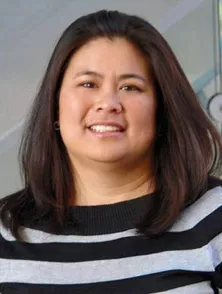
This article appeared in the Fall 2017-Spring 2018 Bryn Mawr Math Alumnae Newsletter.
“JOIN THE NAVY. SEE THE WORLD.” The ad worked. Our latest Bryn Mawr interim math faculty member, Daisy Sudparid, spent five years with the United States Navy in Jacksonville, Florida, and aboard the USS Kitty Hawk, an aircraft carrier, before pursuing an advanced degree in applied mathematics.
It was during Prof. Sudparid’s military training in aviation electronics that she discovered a love of mathematics. In addition to reading schematic diagrams and soldering electrical components, Daisy studied calculus. Aboard ship she was responsible for the communication and navigational systems in various aircraft and enjoyed fixing the components that made them run, but her heart was always with the math.
After a stint spent servicing commercial aircraft for Southwest, Continental, and Hawaiian Airlines, Prof. Sudparid returned to mathematics. She graduated with a bachelor of science degree from the University of Texas at San Antonio, and began teaching algebra, geometry, and AP statistics for a nearby high school.
At first Daisy found it hard to get “buy-in” from her “squirrely” ninth graders, but then she realized they needed a teacher who cared about them personally and could make math relevant to them. To this end she collaborated with innovative colleagues to find a way to reach students. Eventually her commitment paid off, and Daisy was nominated for Teacher of the Year in her district.
A crucial turning point came when Daisy Sudparid met Erica Graham, a tenure-track member of Bryn Mawr’s math faculty. (Their marriage now links Daisy to us.) At the time, Erica was a graduate student in Utah, where Daisy soon relocated. Upon finishing her degree, Erica accepted a post-doctoral appointment at the North Carolina State University. At the same time, Daisy applied to their math graduate program. She was accepted, and she earned a master’s degree in applied math.
Prof. Sudparid attributes her success in teaching to her own struggles in learning math. “Math never came easy to me,” she explains. It was “addictive” though: one mathematical success led to the craving for another. Math was fun, it got her attention, and she wanted to “stay long enough to figure it out.” Daisy enjoys the challenge of changing students’ attitudes about math and about infecting them with the same “addiction” she felt. “The best feeling is when you see the ‘aha’ moment in a student’s eyes and that’s when you know you got ’em!”